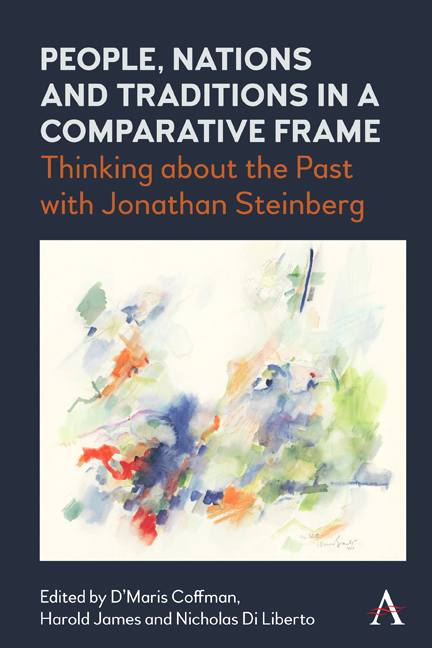172 results
6 - Between Cambridge, Paris, and Amsterdam
-
-
- Book:
- Keynes's <i>Economic Consequences of the Peace</i> after 100 Years
- Published online:
- 14 December 2023
- Print publication:
- 25 January 2024, pp 154-178
-
- Chapter
- Export citation
2 - The Ideology of Central Banking in the Interwar Years and Beyond
- from Part I - General
-
-
- Book:
- The Spread of the Modern Central Bank and Global Cooperation
- Published online:
- 02 November 2023
- Print publication:
- 16 November 2023, pp 40-56
-
- Chapter
- Export citation
3 - Monetary Union and the Single Currency
- from Part I - The Economic and Monetary Union
-
-
- Book:
- The Cambridge Handbook of European Monetary, Economic and Financial Integration
- Published online:
- 28 September 2023
- Print publication:
- 12 October 2023, pp 51-68
-
- Chapter
- Export citation
The Evolve to Next-Gen ACT Network: An evolving open-access, real-world data resource primed for real-world evidence research across the Clinical and Translational Science Award Consortium
-
- Journal:
- Journal of Clinical and Translational Science / Volume 7 / Issue 1 / 2023
- Published online by Cambridge University Press:
- 29 September 2023, e224
-
- Article
-
- You have access
- Open access
- HTML
- Export citation
What Kind of Financial Crisis? - Neil Fligstein, The Banks Did It: An Anatomy of the Financial Crisis (Cambridge Mass., Harvard University Press, 2021, 315 p.)
-
- Journal:
- European Journal of Sociology / Archives Européennes de Sociologie / Volume 62 / Issue 3 / December 2021
- Published online by Cambridge University Press:
- 05 May 2022, pp. 508-513
-
- Article
- Export citation
Part Three - Society, Families and the Sovereign Self
-
- Book:
- People, Nations and Traditions in a Comparative Frame
- Published by:
- Anthem Press
- Published online:
- 23 February 2022
- Print publication:
- 10 March 2021, pp 129-130
-
- Chapter
- Export citation
Part One - Methodological Pluralism and New Applications
-
- Book:
- People, Nations and Traditions in a Comparative Frame
- Published by:
- Anthem Press
- Published online:
- 23 February 2022
- Print publication:
- 10 March 2021, pp 9-10
-
- Chapter
- Export citation

People, Nations and Traditions in a Comparative Frame
- Thinking about the Past with Jonathan Steinberg
-
- Published by:
- Anthem Press
- Published online:
- 23 February 2022
- Print publication:
- 10 March 2021
Frontmatter
-
- Book:
- People, Nations and Traditions in a Comparative Frame
- Published by:
- Anthem Press
- Published online:
- 23 February 2022
- Print publication:
- 10 March 2021, pp i-iv
-
- Chapter
- Export citation
Bibliography of Jonathan Steinberg’s Works
-
- Book:
- People, Nations and Traditions in a Comparative Frame
- Published by:
- Anthem Press
- Published online:
- 23 February 2022
- Print publication:
- 10 March 2021, pp 267-268
-
- Chapter
- Export citation
Contents
-
- Book:
- People, Nations and Traditions in a Comparative Frame
- Published by:
- Anthem Press
- Published online:
- 23 February 2022
- Print publication:
- 10 March 2021, pp v-vi
-
- Chapter
- Export citation
Introduction
-
-
- Book:
- People, Nations and Traditions in a Comparative Frame
- Published by:
- Anthem Press
- Published online:
- 23 February 2022
- Print publication:
- 10 March 2021, pp 1-8
-
- Chapter
- Export citation
Index
-
- Book:
- People, Nations and Traditions in a Comparative Frame
- Published by:
- Anthem Press
- Published online:
- 23 February 2022
- Print publication:
- 10 March 2021, pp 269-273
-
- Chapter
- Export citation
Part Four - History Out of Sync: Modernity and Tradition
-
- Book:
- People, Nations and Traditions in a Comparative Frame
- Published by:
- Anthem Press
- Published online:
- 23 February 2022
- Print publication:
- 10 March 2021, pp 177-178
-
- Chapter
- Export citation
Chapter Four - The Warburgs and Yesterday’s Financial Deterrent
-
-
- Book:
- People, Nations and Traditions in a Comparative Frame
- Published by:
- Anthem Press
- Published online:
- 23 February 2022
- Print publication:
- 10 March 2021, pp 59-70
-
- Chapter
- Export citation
Part Five - History, Narrative and the Human Condition
-
- Book:
- People, Nations and Traditions in a Comparative Frame
- Published by:
- Anthem Press
- Published online:
- 23 February 2022
- Print publication:
- 10 March 2021, pp 223-224
-
- Chapter
- Export citation
Notes on Contributors
-
- Book:
- People, Nations and Traditions in a Comparative Frame
- Published by:
- Anthem Press
- Published online:
- 23 February 2022
- Print publication:
- 10 March 2021, pp xi-xiv
-
- Chapter
- Export citation
Acknowledgements
-
- Book:
- People, Nations and Traditions in a Comparative Frame
- Published by:
- Anthem Press
- Published online:
- 23 February 2022
- Print publication:
- 10 March 2021, pp ix-x
-
- Chapter
- Export citation
Part Two - Personal and National Character
-
- Book:
- People, Nations and Traditions in a Comparative Frame
- Published by:
- Anthem Press
- Published online:
- 23 February 2022
- Print publication:
- 10 March 2021, pp 71-72
-
- Chapter
- Export citation
The Iron Age in the Plastic Age: Anthropocene signatures at Castell Henllys
-
- Article
-
- You have access
- Open access
- HTML
- Export citation



